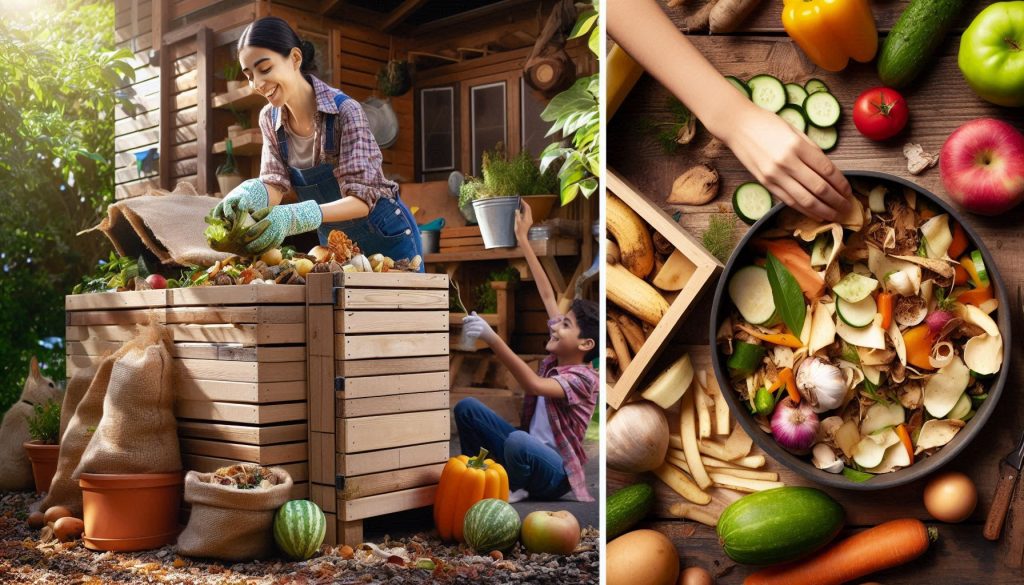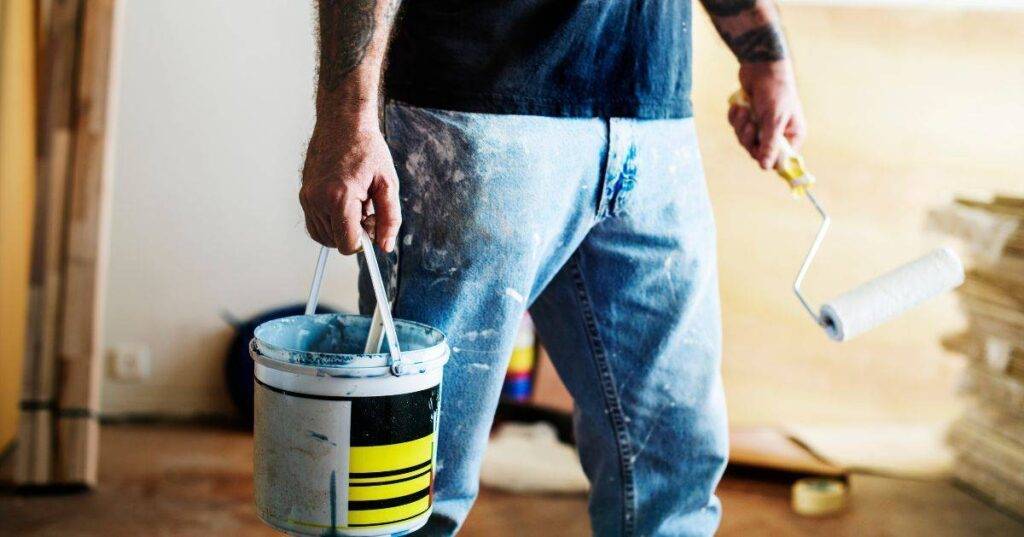Today, environmental issues are more important than ever, and composting is a great way to help manage waste in an eco-friendly way. It reduces the waste that ends up in landfills, improves soil quality, helps plants grow, and even absorbs carbon. By turning food scraps and yard waste into compost, we can make a positive impact on the environment.
This guide will teach you everything you need to know about composting, from the basics to how to build and maintain your own compost bin. Composting is an easy step anyone can take towards living more sustainably. Let’s explore how you can get started and contribute to a greener future.
Understanding Composting
What is Composting?
Composting is a natural process that involves the decomposition of organic matter, such as food scraps and yard waste, into a rich soil amendment known as compost. This process is facilitated by microorganisms, fungi, and invertebrates that break down the material, turning it into a dark, crumbly substance that is beneficial for the soil.
The Science Behind Composting
The composting process involves several stages:
- Aerobic Decomposition: This is the primary method of composting, where oxygen is present. Microorganisms break down organic matter, producing carbon dioxide, water, and heat.
- Thermophilic Phase: As the compost heats up (sometimes exceeding 140°F), thermophilic bacteria thrive, breaking down pathogens and weed seeds, making the compost safe for use.
- Maturation: After the active phase, the compost cools down, and mesophilic bacteria take over, continuing the decomposition process until the compost is stable and ready to use.
Types of Composting
There are several methods of composting, each suitable for different needs and space availability:
- Cold Composting: This method involves piling organic waste and letting it decompose slowly over time. It requires little maintenance but takes longer to produce compost.
- Hot Composting: This method involves mixing green and brown materials to create heat, speeding up the decomposition process. It requires more attention but produces compost in a matter of weeks.
- Vermicomposting: In this method, worms are used to break down organic matter. It’s ideal for small spaces and can be done indoors.
- Bokashi Composting: Using a fermentation process, Bokashi involves adding a special mix of microorganisms to kitchen waste, making it suitable for composting meat and dairy.
Benefits of Composting
Composting offers numerous benefits that extend beyond just waste reduction:
Environmental Benefits
- Reduces Landfill Waste: Composting diverts organic materials from landfills, where they would produce methane, a potent greenhouse gas.
- Decreases Carbon Footprint: By composting, you reduce the need for chemical fertilizers, which require fossil fuels to produce.
- Improves Soil Health: Compost enriches soil with nutrients, promotes beneficial microbial activity, and improves soil structure.
Gardening Benefits
- Nutrient-Rich Soil: Compost provides essential nutrients to plants, promoting healthy growth.
- Enhanced Water Retention: Compost improves soil’s ability to retain moisture, reducing the need for frequent watering.
- Disease Resistance: Healthy soil fosters strong plants that are more resistant to diseases and pests.
Cost Savings
- Reduced Waste Disposal Costs: Composting decreases the volume of waste needing disposal, potentially lowering waste management fees.
- Less Need for Fertilizers: Compost serves as a natural fertilizer, reducing the need for chemical options.
- Improved Plant Health: Healthy plants lead to fewer expenses on pest control and disease management.
Choosing the Right Location
Selecting the right spot for your compost bin is crucial for its success. Here are some factors to consider:
Accessibility
Choose a location that is easily accessible for adding materials and turning the compost. If it’s too far from your kitchen or garden, you might be less inclined to use it.
Well-Drained Area
Ensure the spot is well-drained to prevent water from pooling, which can create anaerobic conditions and lead to foul odors. A slightly elevated area can help with drainage.
Sun Exposure
A balance of sun and shade is ideal. Sunlight helps to heat the compost, speeding up decomposition, while some shade can prevent it from drying out too quickly in hot weather.
Proximity to the Garden
Placing the compost bin near your garden makes it easier to transport finished compost back to your plants. It also allows you to quickly add garden waste.
Materials Needed to Build a Compost Bin
Building a compost bin can be a straightforward project, and you can use various materials. Here’s a list of what you’ll need:
Basic Materials
- Wood: Untreated wood such as cedar or pine is commonly used. Avoid treated wood, as it may contain chemicals harmful to plants.
- Wire Mesh: If you prefer a more open design, wire mesh can provide airflow while keeping the compost contained.
- Tools: Basic tools such as a saw, hammer, nails or screws, and a measuring tape will be necessary for construction.
Optional Materials
- Bricks or Cinder Blocks: For a sturdy, permanent structure.
- Lid or Cover: A lid can help retain moisture and heat, especially in hot climates.
- Aeration Pipes: PVC pipes can be added to improve airflow within the compost.
Step-by-Step Guide to Building Your Compost Bin
Step 1: Design Your Bin
You can choose between different designs based on your space and preference. Here are a few options:
- Simple Heap: For those with ample space, a simple pile works well. Just heap organic materials in a corner of your yard.
- Wooden Bin: A four-sided bin made from wooden pallets or boards is a popular choice. It provides structure while allowing airflow.
- Enclosed Bin: An enclosed design, using wood, chicken wire, or plastic, can help contain smells and pests while keeping the compost contained.
Gather Materials
Once you’ve decided on a design, gather your materials. If you’re using wood, aim for dimensions that suit your space. A 3x3x3-foot bin is a good size for most backyard composting needs.
Step 3: Construction Steps
- Measure and Cut Wood: Cut your wood to the desired lengths for the sides of the bin. If using pallets, you can often skip this step.
- Assemble the Bin:
- For a wooden bin, attach the boards together using nails or screws. Ensure the structure is stable and secure.
- If using wire mesh, create a circular or rectangular frame and secure it with stakes.
- Add Ventilation: Ensure your bin has openings or gaps for airflow, which is essential for aerobic decomposition.
- Ensure Proper Drainage: If building a wooden bin, consider leaving gaps at the bottom to allow excess moisture to escape.
Adding Materials to Your Bin
Once your bin is built, it’s time to start composting!
- Layering: Begin with a layer of coarse materials (e.g., twigs, straw) at the bottom to promote airflow. Follow with alternating layers of greens (nitrogen-rich materials like fruit scraps and grass clippings) and browns (carbon-rich materials like dry leaves and cardboard).
- Moisture Control: Keep the compost damp but not soggy. If it’s too dry, add water or more green materials. If it’s too wet, add more brown materials.
Maintaining Your Compost Bin
Regular maintenance will ensure your compost bin works effectively:
- Turning the Compost: Every few weeks, use a pitchfork or shovel to turn the compost. This aerates the pile and speeds up decomposition.
- Monitor Temperature: A healthy compost pile can reach temperatures between 130°F and 160°F. If it starts cooling down, it may need turning or more materials added.
- Checking Moisture Levels: The compost should feel like a damp sponge. If it’s too wet, turn it and add more dry materials; if it’s too dry, add water or more greens.
Maintaining Your Compost Bin
Adding Materials
To maintain an effective compost bin, regularly add organic materials. Here’s what you can include:
- Greens: Fruit and vegetable scraps, coffee grounds, grass clippings, and plant trimmings.
- Browns: Dry leaves, straw, cardboard, and shredded paper.
What to Avoid
Not all materials are suitable for composting. Avoid adding:
- Meat and dairy products
- Oily foods
- Diseased plants
- Weeds with seeds
- Non-biodegradable materials (plastic, metals)
Signs of a Healthy Compost Bin
A well-functioning compost bin should exhibit the following signs:
- Heat: The pile should feel warm to the touch, indicating active decomposition.
- Smell: A healthy compost bin emits a pleasant, earthy smell. A foul odor may indicate anaerobic conditions.
- Texture: Finished compost will be dark, crumbly, and resemble rich soil.
Troubleshooting Common Composting Problems
Despite your best efforts, you may encounter some issues while composting. Here’s how to troubleshoot common problems:
Odor Issues
If your compost bin smells bad, it may be due to:
- Too Much Green Material: If there are too many greens, the compost can become too wet and produce odors. Add more browns to balance it out.
- Anaerobic Conditions: Lack of aeration can lead to foul smells. Turn the compost more frequently to introduce oxygen.
Pests
Attracting pests can be a concern. To manage them:
- Cover Food Scraps: Always bury food scraps within the compost to prevent attracting flies and rodents.
- Use a Closed Bin: If pests are a persistent problem, consider using an enclosed compost bin.
Slow Decomposition
If your compost is decomposing slowly, check for:
- Insufficient Nitrogen: Add more greens to boost nitrogen levels.
- Poor Aeration: Turn the compost regularly to improve airflow.
- Too Dry: If the compost is too dry, add water or moist materials.
Building and maintaining a compost bin is a rewarding endeavor that contributes to sustainable waste management. By composting, you reduce landfill waste, enrich your garden soil, and support a healthier planet. As you embark on this journey, remember that composting is a learning process. Don’t be discouraged by challenges; instead, embrace them as opportunities to improve your practices.
Conclusion
Encourage your friends and family to join you in composting, and share your experiences with others. Together, we can make a significant impact on our environment, one compost bin at a time. Start your composting journey today and enjoy the benefits of sustainable waste management.



